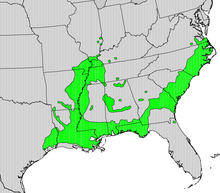Water Tupelo
| Nyssa aquatica | |
|---|---|
 |
|
| A stand of Nyssa aquatica (water tupelo) | |
| Scientific classification | |
| Kingdom: | Plantae |
| (unranked): | Angiosperms |
| (unranked): | Eudicots |
| (unranked): | Asterids |
| Order: | Cornales |
| Family: | Cornaceae (Nyssaceae) |
| Genus: | Nyssa |
| Species: | N. aquatica |
| Binomial name | |
|
Nyssa aquatica L. |
|
 |
|
| Natural range. | |
Nyssa aquatica, commonly called the water tupelo,cottongum,wild olive,large tupelo,sourgum,tupelo-gum, or water-gum, is a large, long-lived tree in the tupelo genus (Nyssa) that grows in swamps and floodplains in the Southeastern United States.
Nyssa aquatica trunks have a swollen base that tapers up to a long, clear bole, and its root system is periodically under water. Water tupelo trees often occurs in pure stands.
Nyssa aquatica's genus name (Nyssa) refers to a Greek water nymph; the species epithet aquatica, meaning ‘aquatic’, refers to its swamp and wetland habitat.
One of the species' common names, tupelo, is of Native American origin, coming from the Creek words ito ‘tree’ and opilwa ‘swamp’; it was in use by the mid-18th century
A large mature tree can produce commercial timber used for furniture and crates. The swollen base of the Nyssa aquatica is the source of a favored wood of wood carvers.
Many kinds of wildlife eat the fruit, and it is a favored honey tree.
...
Wikipedia
